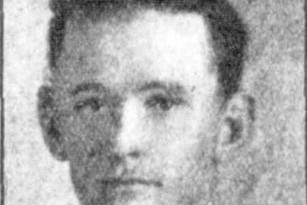General News
20 July, 2024
Veterans' Voices: Ira Warren Gunn
- Sally Bertram, RSL Military History Library. / Contact Sally at sj.bertram@hotmail.com or call 0409 351 940.

Ira Warren Gunn was born in Nhill in 1894, the fourth son of William George Gunn and Annie Valerie (Sheriff) Gunn or Fernleigh, Nhill.
He received his education under Jas McGregor at Nhill School and gained his Merit Certificate at the age of 13 years.
After leaving school he briefly entered Messrs Trumble and Palmer's offices but subsequently decided to go into partnership with his father as a general builder.
His occupation on enlistment was stated as painter.
Ira was an active member of the Jeparit swimming, rowing and football clubs and a member of the coursing club.
He was also recognised as a very capable exponent of the art of self defence.
Ira lived in Rockley Street, Nhill, and was aged 21.
He had previous service in the senior cadets at Nhill.
Shortly after the outbreak of the war Ira enlisted on August 25 1914 with his brother, Corporal W Gunn, at Jeparit, with the service number 408.
His unit was 8th Battalion D Company.
Ira sailed from Melbourne on board Transport A24 Benalla on October 19 1914.
Ira served in Egypt, at Gallipoli and on the Western Front.
In Turkey Ira became one of the original Anzacs, taking part in all the heavy engagements on the Gallipoli Peninsula.
He was promoted to the rank of sergeant in France and when writing home always said he would not return to Australia until the war ended.
During his service he was awarded a Distinguished Conduct Medal for conspicuous courage and devotion to duty in an attack east of Ypres in Belgium on October 4 1917, inspiring men of his platoon and rendering valuable services.
He took command of his platoon when his officer became a casualty, and during the advance encountered an enemy party assembling for an attack.
Ira rushed forward, firing his rifle, and the enemy fell back to a concrete dugout, where they held up the advance by machine gun fire.
He attacked and silenced the machine gun, capturing the entire crew.
His courage was said to have "set a splendid example to his men".
Ira was killed in action on April 16 1918, aged 23.
A Reverend Henry Swan of the Presbyterian Church was notified by the Defence Department that Sergeant Ira Warren Gunn DCM, the fourth son of Mrs WG Gunn of Fernleigh, Rockley Street, Church Hill, had been killed while fighting with the AIF in France.
The Rev Swan then broke the sad news to Mrs Gunn and another of her sons, Vic Gunn.
It was reported that "general regret was expressed by his friends in Nhill and Jeparit on Saturday when news of hs death was received, as he was a general favourite and noted for his fine manly conduct, as a private citizen and also in the sports arena".
By cruel coincidence, the news of Ira's death was received on what would have been his birthday.
Deep sympathy was expressed to his bereaved mother, sisters and brothers.
The flags were lowered to half-mast in Nhill as a mark of respect for the gallant young Anzac who fell fighting for king and country.
Ira Warren Gunn was buried at Nieppe-Bois (Rue-Du-Bois) British Cemetery (Row B, Grave No14) in Vieux-Berquin, France.
Ira's name is on panel 53 in the Commemorative Area at the Australian War Memorial.
Ira was entitled to receive the Distinguished Conduct Medal, the 1914-15 Star, the British War Medal and the Victory Medal.
His brother Corporal William Henry Gunn (service number 867), Australian Army Service Corps –Motor Transport Section, returned to Australia on December 3 1918.
The Battle of Hazebrouck (including the Defence of Nieppe Forest) - one of the Battles of the Lys - lasted from April 12 to 15 1918.
The line east of Nieppe Forest was defended against overwhelming forces by the 29th and 31st Divisions, the latter including the 4th Guards Brigade.
Although Vieux-Berquin village was lost on April 13, the rest of the line was held until the 1st Australian Division had detrained and arrived on the field.
The Nieppe-Bois cemetery was used from April until September 1918.
It was used again during World War II for burying casualties of the battles covering the withdrawal to Dunkirk in May 1940.
Nieppe-Bois (Rue-du-Bois) British Cemetery now contains 70 World War I burials and 33 from World War II.
With thanks: Sally Bertram, RSL Military History Library. Contact Sally at sj.bertram@hotmail.com or call 0409 351 940.